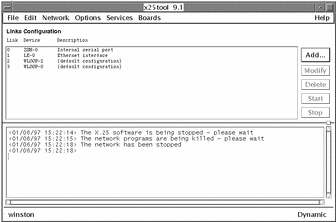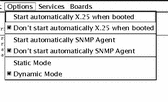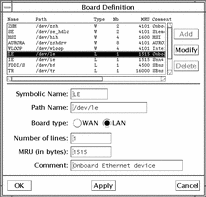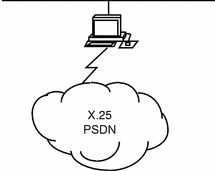Chapter 4 Configuring Solstice X.25 Using x25tool
This chapter describes how to access and use x25tool to configure X.25.
x25tool Overview
x25tool provides a graphical interface to the parameters required to configure and maintain the Solstice X.25 software. The parameters are contained in a set of configuration files which also can be edited directly. See Chapter 5, Configuring Solstice X.25 by Editing the Configuration Files, for more information.
Starting x25tool
To start x25tool with read and write permission, log in as root or become superuser, and type:
hostname# /opt/SUNWconn/bin/x25tool |
Note -
Starting x25tool without root permission gives you read-only access.
Using x25tool
When you start x25tool, the main window appears. The top of the window provides menu options for configuring X.25. Directly underneath the menu is a list of currently configured links.
The lower half of the window displays output messages. For example, when you start or stop a link, information is displayed in the output window.
Figure 4-1 x25tool Main Window Overview

To select an item in x25tool, position the mouse cursor on the item and click the left mouse button.
Note -
If you move the mouse cursor into the output window and click on the right mouse button, you will see a pop-up window for saving or clearing the output.
Some menu options are "yes/no" options; the menu contains a list of items. Click on the box next to an item to select or unselect it. A shaded button indicates that the option is currently selected.
Figure 4-2 Selecting an Option

Some menu options are associated with pop-up windows:
Figure 4-3 A Menu Option Associated with a Pop-Up Window

There are various ways to enter information. You may need to type the information in directly, select the information from a list, or click on a button to access additional parameters in another window.
Updating the Configuration
Once you have made changes and are ready to exit the window, you have three options: OK, Apply, or Cancel.
-
OK updates the changes you have made and dismisses the window.
-
Apply updates the changes, but does not dismiss the window.
-
Cancel discards the changes you have made and dismisses the window.
Dynamic Mode and Static Mode
Figure 4-4 Updating the Network Configuration

The x25tool runs in one of two modes: dynamic and static. Which mode you use affects how modifications to the configuration are handled.
To set the mode, select Options from the x25tool menu and click next to the mode in which you want to run x25tool.
If you run x25tool in dynamic mode, when you click on OK or Apply, all the modifications are transmitted to the protocol stack that is currently running on the machine, but are not permanently stored to the configuration files.
If you run x25tool in static mode, any modifications you make will not be applied to the currently running configuration. If you want to transmit the modifications to the currently running protocol stack, you must first save the configuration modifications using File => Save, or File => Save As, then select Network => Stop X.25 or Network => Start X.25.
Note -
In both dynamic and static modes, the configuration modifications are not automatically saved. If you want to store the configuration to use the next time you start the network, you must use File => Save, or File => Save As.
x25tool Menu Items
File
Save
Save changes to the default configuration files. When you click on Save, a window displays a list of settings (IP Configuration, Link #, PAD Host Database, etc.) and you can choose which settings you want to save to the default configuration. By default, all modified items are listed under Save.
Save as
Save changes to a named configuration. You might want to keep a backup, for example, or create a template configuration suitable for your particular network.
As with the Save option, you can choose which information to save to the configuration files.
Load from
This lets you load different configuration information into x25tool from a previously saved configuration.
Load running
This lets you load configuration information related to links, routing, and NUI mapping, from the X.25 session currently running into x25tool.
Exit
Exit x25tool.
Edit
Add Link
When you select Add Link, a list of configuration templates is displayed. Choose the template that most closely matches your configuration needs (e.g. TELENET, TRANSPAC, or TYMNET) or choose the Default. The Link Editor window will appear. You can then add a new link and configure it.
Modify Link
Lets you modify the link that is currently selected in the Links Configuration list by bringing up the Link Editor window. (Alternatively, you can double-click on the link to bring up the Link Editor window.) You can then modify the selected link.
Delete Link
Deletes the link that is currently selected in the Links Configuration list.
Note -
The link must not be running when you delete it. See "Stop Link", for more information.
Copy Link
Copies the link configuration information for the link that is currently selected in the Links Configuration List. You can only copy configuration information for one link.
Paste Link
Pastes the most recently copied configuration information of a single link into the Link Editor window.
Link Editor
When you choose Edit => Add to add a link, or Edit => Modify to modify an existing link, (see "Add Link" and "Modify Link" for more information), the Link Editor pop-up window will appear. The Link Editor window contains the options you need to configure the link.
The Link Editor is divided into three rows which correspond to the three lowest layers of the OSI seven-layer model. The top row contains the layer one physical parameters; the middle row contains the layer two frame parameters, and the bottom row contains layer three packet parameters.
The Link Editor window is also arranged so that the left side contains the more basic parameters used to configure a link. In most cases, these parameters are all you need, but the buttons on the right side of the Link Editor will take you to the Advanced Configuration windows. You can use the parameters in these windows to further fine-tune the link configuration.
Figure 4-5 Link Editor Window

Network
Start X.25
Starts the Solstice X.25 network.
Stop X.25
Stops all the daemons associated with the X.25 system software.
Statistics X.25
Gathers and displays statistics on traffic. When you select this option, a pop-up window will appear. The options displayed in this window let you determine the kind of statistical information to be generated:
Figure 4-6 Network X.25 Statistics Window

- Protocol
-
Select the protocol(s) you want to generate statistics for: WAN, LAPB, LLC, MLP, X.25, or IXE.
- VC(s)
-
Select one of the following: Total for all VCs; Per-VC, all VCs; Per-VC, single VC; or Per-VC, range of VCs.
Note -Statistics for the VC (virtual circuit) are reported only if X.25 is one of the protocols selected.
- VC or VC Range
-
If you set VC(s) to Per-VC, you will need to specify the VC number. If you select Per-VC, range of VCs, you will need to enter the range of VCs to be used for gathering the statistics.
- Link(s)
-
Select one of the following: Total for all links; Per-link, all links; Per-link, single link; Per-link, range of links
- Link Number or Link Range
-
If you set Link(s) to Per-link, single link, you will need to specify the link number. If you select Per-link, range of links, you will need to enter the range of links to be used for gathering the statistics.
- Interval
-
This field is optional. If you enter a value, the updated statistics will be continuously re-displayed after the interval specified. Interval values are in seconds.
- Log Report
-
If you select Yes, you will be prompted to give a file name for storing the statistics. If you select No, the statistics are displayed in the statistics window, only.
To generate a report, click on the protocols you want statistics for, specify the link(s) and VC(s) to test, and the interval. Then click on Display. Following is an example of how the statistics are reported:
GLOBAL STATISTICS FOR X25 ------------------------------------- Packet type TX RX ------------------------------------- Call 20 20 Call accept 20 20 Clear 0 0 Clear Confirm 0 0 Restart 5 5 Restart confirm 0 0 RNR 0 0 RR 2431 2430 Resets 0 0 Reset confirms 0 0 Diagnostic 0 0 Interrupts 0 0 Registration 0 0 Reg confirm 0 0 Packets(total) 4250 4212 Bytes(total) 483584 483640 ------------------------------------- Running totals ------------------------------------- Tot no of VCs established 2 Connections refused 0 Connections currently open 2 Max connections open 2A separate block of statistics is reported for each protocol selected.
Start Link
Starts the currently selected link without affecting the Solstice X.25 software as a whole. All counters and timers associated with the link protocol are reset to their initial values.
Stop Link
Stops an individual link without affecting the Solstice X.25 software as a whole. All counters and timers associated with the link protocol are reset to their initial values.
Once the link has been stopped, the LAPB will not respond to any incoming frames until the link is restarted using the Start Link option.
Reset Link
Resets an individual link to its initial state without affecting the Solstice X.25 software as a whole. All counters and timers associated with the link protocol are reset to their initial values.
Link(s) status
Displays the status of the internal state of the LAPB for the configured links. When the link is operating normally, i.e. the SABM/UA handshake has successfully completed, the state for both LAPB and Packet is displayed as NORMAL.
When used on a MLP link, the highest status of the different SLPs is displayed.
For more information on link status, see Chapter 11, Troubleshooting.
Note -
The link status option does not work with LLC2 links.
Options
Start X.25 automatically when booted
The X.25 network will automatically start the next time you reboot the machine.
Don't start X.25 automatically when booted
The X.25 network will not automatically start when you reboot the machine. If you want to bring up the network later, then you must select Network => Start X.25.
Start SNMP Agent automatically
This starts the SNMP agent when you start X.25 or reboot the machine. The SNMP agent allows access to the MIB through SNMP (the Simple Network Management Protocol). For more information on the SNMP agent, see Appendix E, Using the Solstice X.25 SNMP Agent.
Don't start SNMP Agent Automatically
The SNMP agent will not be started when you start X.25 or reboot the machine.
Static mode
When x25tool is set to static mode, any changes you make will not be applied to the currently running configuration. However, if you save the changes to the default configuration files, they will come into effect the next time you stop and restart the Solstice X.25 software.
Dynamic mode
When x25tool is set to dynamic mode, any change you make will affect existing X.25 connections, and may disrupt users, so use caution. Changes to the dynamic configuration are made in the kernel and are lost the next time you restart the Solstice X.25 software, unless you save the changes.
Services
The following Service options are described in more detail in Chapter 6, Configuring Solstice X.25 Services and Chapter 7, Parameter Reference.
IP
Configure X.25 to run IP above it. There are two IP windows: the IP Interface Configuration window, and the Remote Host to X.25 Address Map window.
PAD
Configure the PAD Hosts Database with information to make it easier for users to make PAD calls to a remote host.
The PAD Daemon Listen Database window lets you determine how incoming calls will be handled.
The PAD Printer lets you install a printer over an X.25 network so that users logged in from a remote terminal can still print to their local printer.
NUI Mapping
Configure the Network User Identifier parameters to create a mapping between the Network User Identifiers and facilities.
Routing
If you have multiple links, use the parameters in this window to configure the address information in a Call Request packet. This determines which link Solstice X.25 will use for outgoing calls.
X.25 Call Filtering
Use X.25 Call Filtering to define which incoming calls will be authorized.
Boards
Definition
This pop-up window contains a list of physical serial port boards. Click on Add to add a board, or click on a board already displayed in the list, then select Modify.
When you click on Apply or OK, the changes are stored in a file and the Device list for the Link Editor is updated to reflect any additions or modifications.
The items contained in the definition window are:
Symbolic Name
This is what you want to call the board.
Path Name
This is the path for the device driver, for example, /dev/zshdrv is the location for the Aurora board driver.
Board type
Set to either WAN or LAN.
Number of lines
This is the number of lines that the board will support.
MRU (in bytes)
The size of the largest frame (Maximum Receive Unit) that can be received by the board.
Comment
Type in any additional information you want to include, for example, "Onboard Serial Port".
Help
On-line help for x25tool is available in HTML format. It is specifically structured to help you quickly find the answers to questions about x25tool. For example, if you are not sure what sort of information to type in the Local X.121 Address field in the Link Editor window, you can use on-line help to find out.
The first time you use on-line help, you need to specify which browser to use. To do this, click on Help and select Properties. Then type in the path and name of the browser and click on OK.
Alternatively, you can specify the browser in your .login file by adding the following line:
setenv X25HTMLBROWSER = /pathname/browsername
Then, to bring up the on-line help, just click on Help => Help. This starts the browser and brings you to the main help menu. You can then follow the hyperlinks to the information you need.
Configuring a Single WAN Link
This section describes how to use the Link Editor in x25tool to configure a single dedicated WAN link for Solstice X.25. The configuration described in this chapter uses the default values provided with the product. It should work in the majority of situations, although it will not necessarily make the best possible use of the product's capacities.
No changes will be made to the Advanced Configuration settings in this example; however, once you have a link that works, you can use the Advanced Configuration options to fine-tune it. See Chapter 7, Parameter Reference for more information.
This example uses the SPARCTM version of the product. The process is almost identical for all versions of the product, but the device names change. Refer to Chapter 8, Example Configurations, for an example using the x86 version of the product.
The procedure for setting up a dial-up link is slightly different from that for setting up a leased line, and involves some extra considerations. Refer to Chapter 8, Example Configurations for an example.
This section describes setting up the following configuration:
Figure 4-7 Configuring a Single WAN Link using x25tool

The onboard serial port of the workstation is connected to a modem using a straight-through cable. When you subscribe to a PSDN, your supplier almost always provides a modem. If not, contact the supplier to find out what kind of modem you need.
To configure Solstice X.25, you need to:
-
configure some information about the link
-
change the logical channel ranges used by the Solstice X.25 software to match those used by your PSDN
Before you start, make certain that your PSDN supplier has provided the following information:
-
the version of the X.25 Recommendation used on the PSDN
-
the logical channel ranges used by the PSDN
By default, there are two template links already configured, one WAN link and one LAN link.
In this example, you will configure a single WAN link:
-
In the x25tool main window, pull down the Edit menu, select Add Link and choose a template configuration.
If you don't know what template configuration you need, choose Default. The Link Editor window appears:
Figure 4-8 The Link Editor Window

-
Set the Link Number.
This is a unique number that you assign to the link to identify it, both in x25tool and in the configuration files.
-
Type a link description (this is optional).
In the Link Description field, type in a description of the link. For example, Internal serial port.
-
Set the Link Type.
Pull down the Link Type menu and choose WAN.
-
Set the Device type and Port Number.
The example uses the default zsh0 device. If you are using a different device type, pull down the menu of available device types and select the relevant one, then type in the port number.
-
Make sure the Interface is set as DTE.
You only need to set the Interface as DCE if you are running two machines back-to-back, for example for testing.
-
Set the LAP Protocol to LAPB, unless you are sure your PSDN uses a different LAP Mode.
LAP and LAPBE are used very rarely.
-
Set the Local Address.
Type the port address in this field. This is the X.121 address assigned to you by your supplier. This address is often referred to as an X.25 address. Your service supplier should tell you this address.
Note -The Full Address and Extended Address parameters are not used when the product is in normal operation. You only need to enter these if you are using an application that expects to read them. In this case, your service provider will tell you what you need to enter here.
-
Select the Version.
Choose the version of the X.25 recommendation used by your PSDN.
-
Set the Logical Channel ranges:
Your PSDN will tell you which values to use here. If you are configuring a private network, all machines on the network must use the same logical channel ranges. In this case, you can choose any values you like as long as they comply with the X.25 Recommendations.
-
Click on OK.
This confirms your changes and closes the Link Editor window.
-
Click on File, then click on Save.
This makes sure your changes will be used next time you start X.25.
Note -For a default configuration, you do not need to configure the datalink layer parameters, the defaults should be adequate.
-
Start X.25 by pulling down the Network menu and clicking on Start X.25.
-
Check that the configuration is valid.
First, check the link status by clicking on Network, Link Status. The link status should be NORMAL.
-
Next, make a PAD call to yourself. To do this, enter the pad command at a command line, followed by your own X.121 address:
hostname% pad X.121 address
Once you have created a link that works, you can fine-tune it, or configure the application(s) you want to run over it.
Chapter 8, Example Configurations contains additional examples.
- © 2010, Oracle Corporation and/or its affiliates
